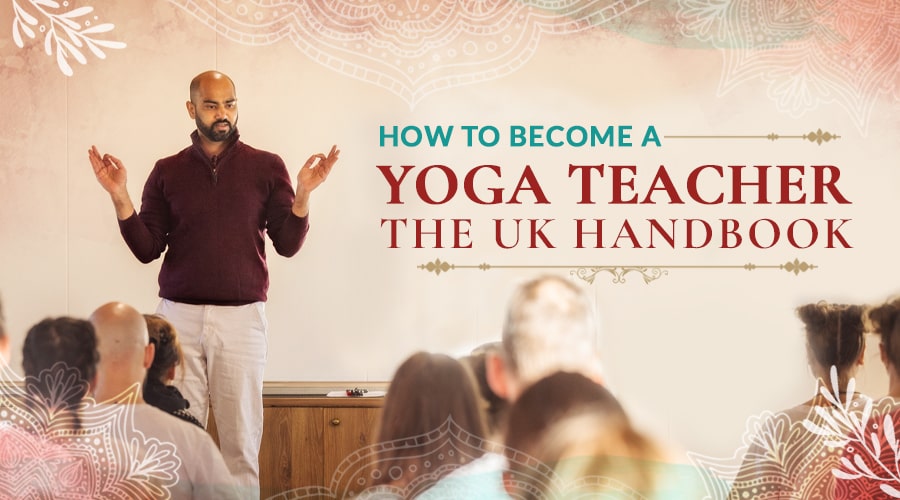Our love for yoga spans far and wide. In fact, it’s estimated that 300 million people practise yoga globally with the community continuing to grow. If you’re one of these passionate practitioners, then the thought of becoming a yoga teacher has probably crossed your mind more than once. Personally, it was the best decision I made. Becoming a teacher means that yoga can be part of your daily life, and better yet, you get the chance to share it with others. But how do you become a yoga teacher in the UK?
As a Senior Yoga Teacher Trainer for more than 16 years and the Co-Founder of Arhanta Yoga Ashrams, I’ve trained more than 18,000 students from across the world. In this time, I’ve seen many students battle with same questions and concerns about becoming a yoga teacher, whether it’s how to start a thriving career or choose the right yoga teacher training course. So, I've put this comprehensive handbook together to cover everything aspiring UK yoga teachers need to know to take the next step in their career with confidence.
What Do You Need to Become a Yoga Teacher in the UK?
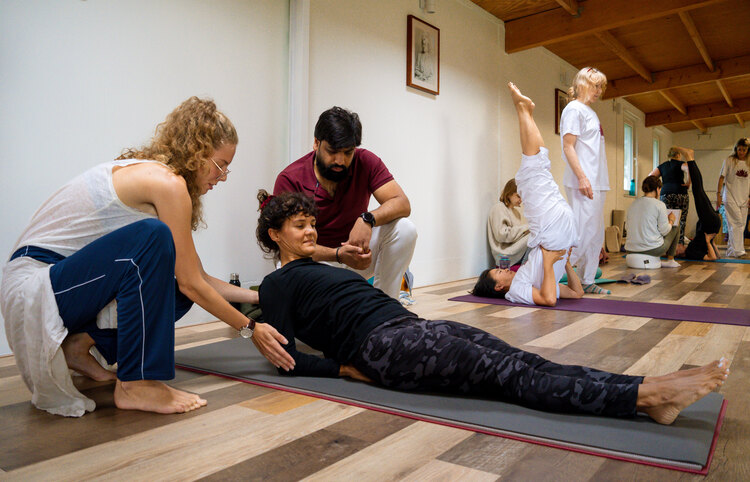
Generally speaking, anyone with the passion and desire to learn yoga can become a yoga teacher. However, there are a few requirements UK yoga associations and studios expect you to have, such as a 200-hour yoga teacher training course (Yoga Level 1), a GCSE (General Certificate of Secondary Education), as well as some teaching experience.
Qualifications
Major yoga associations like the Yoga Alliance and International Yoga Association, as well as UK-based groups such as the British Wheel of Yoga regard the 200-hour yoga teacher training (YTT) as the minimum requirement to teach yoga professionally in the United Kingdom. This course is designed to introduce practitioners to the wide and often complex world of teaching yoga, covering the fundamental aspects of yoga asana practice, philosophy, physiology, and anatomy.
Once completed, you receive a 200-hour certificate that is internationally recognised by studios, gyms, and professional yoga associations. The 200-hour yoga teacher certification also classifies you as a Level 1 – RYT 200 (Registered Yoga Teacher 200 Hours), which allows you to enter classrooms around the world and teach professionally.
Experience
If you want to become a yoga teacher in the UK, some yoga experience is recommended before you enrol in a YTT, although not required.
At Arhanta Yoga Ashrams, we have complete beginners enrol with very little experience. While hesitant at first, our 26-day, intensive yoga teacher training course is designed to equip them with the skills, knowledge, and confidence to begin teaching almost immediately. However, some students may need more time or a different learning environment—every student is different.
It’s important to note that many yoga jobs in the UK prefer a year of hands-on experience and a proven track record of teaching yoga. So, seizing every opportunity to teach different students and develop your skills will be key to a successful career as a yoga teacher.
Licence/Legal Requirements
There is currently no existing law in the United Kingdom that regulates the practice of teaching yoga. The UK government, as well as national yoga associations and professional bodies, do not require teachers to have a licence or any legal certifications to teach yoga, but you do need to have the right to work in the country.
How to Become a Yoga Teacher in the UK Step by Step
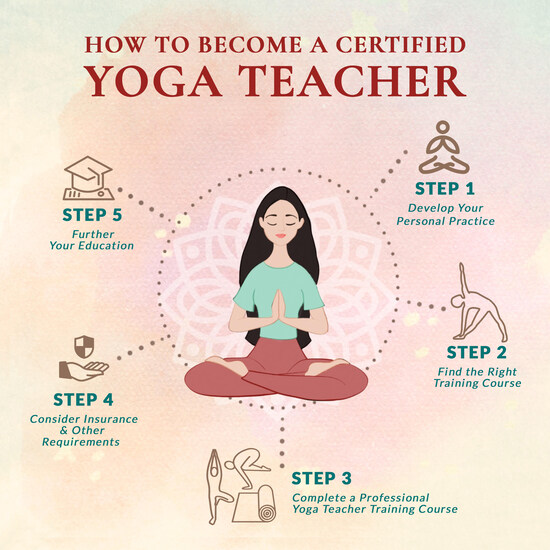
To become a yoga teacher in the UK, start by completing a 200-hour yoga teacher course at an accredited school. While optional, registering with a professional yoga alliance is recommended. After certification, you can join a studio, further your education, or start your own business—every practitioner’s path will be unique.
Below is a detailed guide that you can follow for each of the major steps to becoming a yoga teacher. Approach these steps with patience, never take shortcuts, and remember, teaching yoga is a life-long journey.
Step 1: Develop Your Personal Practice
While not mandatory, many UK yoga teacher training programmes suggest developing your personal practice before enrolling. This could be improving your physical fitness and flexibility by attending studio classes, or following yoga philosophy lessons on YouTube to deepen your understanding of the practice—anything to kickstart your learning and ignite your passion for yoga.
This period is also great for exploring the many different styles of yoga, such as Yin, Hatha, and Vinyasa Flow, to name a few. When you feel that you have a basic understanding of yoga and what it's like to be a yoga teacher, you will be ready to enrol in a 200-hour YTT.
Step 2: Find the Right Training Course
Choosing the right yoga teacher training course is one of the most important steps in becoming a yoga teacher. You need to consider numerous factors like cost, curriculum, learning style, language, location, and how it aligns with your personal and professional goals.
A good place to start is by looking at Registered Yoga Schools (RYS) who offer courses that are yoga-alliance certified and meet the UK and international standards of 200 hours of training. These schools are usually registered with major yoga associations and institutions like the Yoga Alliance, International Yoga Federation, and European Yoga Association. Their yoga certifications should also be recognised and accepted by yoga insurance companies.
Lastly, I’d suggest looking at the school’s course reviews and social media presence before making the final decision. This will give you a better understanding of the training experience offered and if it's right for you.
Step 3: Complete a Professional Yoga Teacher Training Course
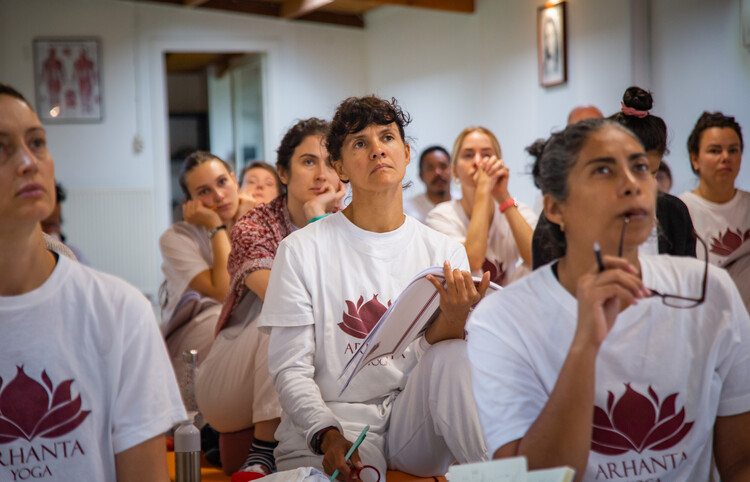
Once you have found a programme you like, enrol and complete the training. There are a few ways you can prepare yourself for a yoga teacher training, but the purpose of these courses is to challenge you in new ways and maximise your growth as a practitioner and teacher.
At Arhanta Yoga Ashrams, training includes daily intensive yoga and enriching lessons on yoga philosophy and anatomy. Expect lifestyle changes like new eating and sleeping habits and shifts in your body and mindset. Practicum hours give you a chance to teach and learn from peers, providing valuable hands-on experience.
Emotionally, there will also be a few ups and downs due to the physical intensity, strict routines, and being away from familiar surroundings, especially in an ashram setting. But it's all part of the transformative journey.
For online learners, you can practise at your own pace, but you'll need to stay dedicated and self-disciplined—consistency is key. Just like in an ashram training, you'll cover the fundamentals of yoga, from poses to meditation, as well as yoga philosophy, theory, and more. After completing your training, you can register with a recognised yoga association as a Level 1 RYT-200.
Read: Residential vs Non-Residential Training - What’s the Difference?
Step 4: Consider Insurance & Other Requirements
As mentioned above, there are no legal requirements to become a yoga teacher in the UK. However, to succeed and practise yoga safely, it is strongly advised to take out public liability insurance of at least £2 million to cover you in the event of injury and property damage.
Registering with an international yoga association or national body is also advised as it shows gyms and studios that you have been trained to a high standard. For some gyms and studios in the UK, it is a requirement to be a member of recognised yoga and physical activity organisations like the Yoga Alliance, REPs (Register of Exercise Professionals), CIMSPA (Chartered Institute for the Management of Sport and Physical Activity), and the British Wheel of Yoga. Most of these groups can be joined online using your yoga certification and might require an annual membership fee that can range from £36 to £99.
Step 5: Further Your Education
Many yoga teachers go on to complete an advanced 300-hour yoga teacher training course to gain a deeper understanding of yoga and become a Level 2 – RYT 500. Different from a 200-hour YTT, this course provides in-depth lessons on advanced yoga philosophy and physiology, as well as various other yoga styles like Vinyasa and Yin Yoga.
If you're an RYT or an Experienced Registered Yoga Teacher (E-RYT), you'll need to complete 75 hours of Continued Education every three years after your first registration to keep your certification status. 45 hours should be spent teaching yoga, while the remaining 30 can be done through online yoga teacher training courses or other distance learning options.
As a result, many teachers enrol in shorter 50-hour courses that explore yoga styles a 200-hour YTT only briefly touches on, such as Yin, Prenatal, and Yoga Nidra. These not only broaden your skills in different yoga styles, meditation, and pranayama, but also help keep your own yoga practice alive.
At the end of the day, the most important thing to remember is that yoga is a life-long journey of growth and continuous learning. Although I have 40,000+ hours of experience, I am still learning from my students and take every opportunity to continue my studies in yoga.
Also Read: 50-, 100- & 200-Hour Yoga Certification Courses? Differences Explained
How Much Does a Yoga Teacher Training Cost for UK Students?
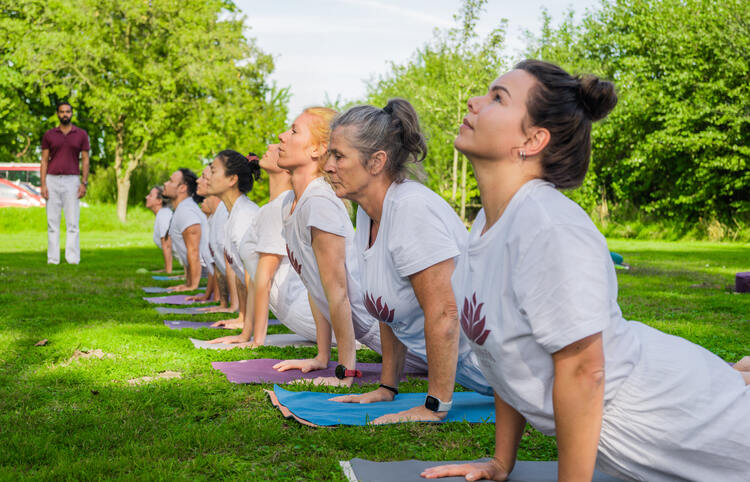
If you're looking for an authentic yoga experience, studying in India is a truly unique and life-changing journey. The cost of Arhanta’s all-inclusive, 200-Hour Yoga Teacher Training Course in India starts at £1540 and goes up to £1925, depending on accommodation and when you book. Adding roundtrip flights from London to Delhi (£270) and visa fees (£21), the total cost for UK students amounts to around £1831.
Enrolling in a teacher training course in Europe is also a great option for aspiring yoga teachers in the UK. The cost of an all-inclusive, 26-day YTT in the Netherlands ranges between £2268 and £3125, and flights can be as cheap as £60 for a round-trip to Amsterdam from London.
For those who don't have the time or funds to study abroad, there are also online yoga teacher training programmes available for £1275. While virtual, these yoga courses still certify you as a qualified yoga teacher, covering all the knowledge and skills you need to begin teaching professionally in the UK.
It is recommended though that you pick up a few more hours of in-person teaching experience typically provided in an ashram training. For example, to join CIMSPA as a Yoga Instructor Associate, you will need 200 hours of training with 160 hours of direct contact with your mentor or teacher.
Also See: Benefits and Drawbacks of Online Yoga Teacher Training
How Long Does It Take to Become a Yoga Teacher?
Yoga teacher training programmes require a minimum of 200 hours of study. This can be completed over several months or just 26 days, depending on your budget, schedule, and learning preferences.
For instance, at Arhanta Yoga, we offer a 4-week intensive yoga teacher training course designed to challenge and shape students into confident, well-rounded yoga teachers in only 26 days. The fast pace and full days of yoga practice, teaching methods, anatomy study, and philosophy classes make for a concentrated yet transformative experience.
There are many benefits of this accelerated approach, especially in terms of personal and professional growth. But when choosing a YTT, it’s essential that you take into account your specific budget, learning style, and what you hope to gain at the end of the course.
Do You Need to Register with a Yoga Association?
It is recommended that new teachers register as a member of a yoga alliance after completing a 200-hour yoga teacher training to show prospective employers and students that they are qualified and uphold the high standards set by an independent organisation.
There are also other groups in the UK, such as the Yoga Alliance Professionals (formerly Yoga Alliance UK) and the British Wheel of Yoga that share the latest yoga developments and provide trainings that meet the necessary requirements, but it is not compulsory to be a member.
How Much Do Yoga Teachers Get Paid in the UK?
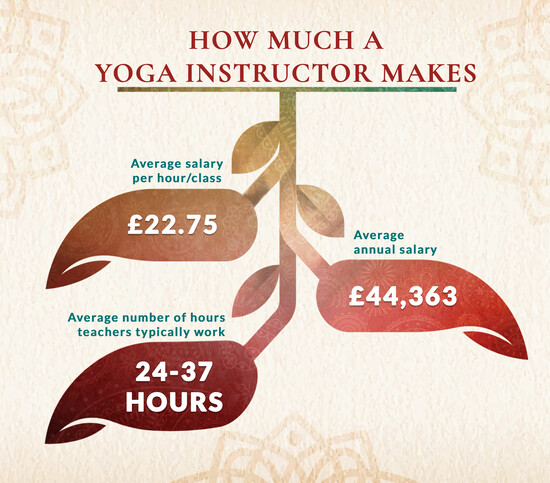
Based on more than 300 salaries reported by Talent.com in 2024, the average yoga teacher salary in the United Kingdom is £44,363 per year and £22,75 per hour/class. The amount will of course vary depending on your experience, location, and schedule.
For example, new yoga teachers working in junior positions can expect to earn up to £35,000 per year, while more senior teachers with several years of experience can make anywhere between £40,000 and £60,000 per year.
Location is probably one of the most important factors for yoga teachers wanting to earn a high salary. According to Indeed, yoga teacher jobs in large cities like Edinburgh and Liverpool were some of the highest paying, averaging between £35,48 and £38,34 per hour/class. Meanwhile, jobs in smaller towns such as Royal Tunbridge Wells offered teachers around half at £13.66 per hour.
What Job Opportunities Are There for Yoga Teachers in the UK?
Outside of teaching yoga at a studio or gym, there are many different ways to make a living as a yoga teacher, such as managing a retreat centre or even starting a YouTube channel. Newly certified yoga teachers tend to work at smaller, local studios first before going on to work in large gym settings or retreats. Some also go off to specialise in specific styles like Prenatal or Kids and Teen Yoga, helping others heal and find balance in their lives through yoga.
If you are newly certified and struggling to find a job in the UK due to experience or a lack of connections, try taking classes at the studios you’d like to teach at and introduce yourself to the trainers and owners. By building a relationship with the managers and other employees, you get a foot in the door and are much more likely to be hired.
It’s also very popular for new teachers to rent a studio space and provide their own classes, perhaps at a reduced rate at first while building their client base. Sharing yoga tutorials and tips on social media platforms like Instagram or TikTok is another great way to get exposure in the community and kickstart your career.
For many mid-senior teachers, the next step after working as a yoga teacher is to start your own yoga business. There are various avenues you can take, each with its own unique challenges, so enrolling in a yoga business course can provide useful tips and guidance in your personal journey.
Final Thought
Becoming a yoga teacher in the UK or abroad is a challenging and rewarding journey, offering profound personal and professional growth. The path is not easy though; it demands dedication, patience, and a willingness to confront and overcome personal limits. However, the rewards are immeasurable. You gain not just flexibility and strength, but also a deeper understanding of yourself and a unique ability to inspire growth in others.

